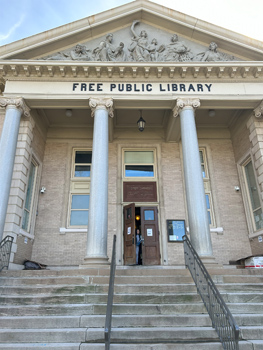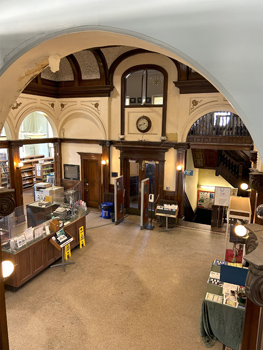By: Morgan Garrow
Rutgers University Intern
The New Brunswick Free Public Library, operating for the past 120 years, has served the citizens of New Brunswick, New Jersey, as a wonderful resource. Still, few people recognize its significance and rich history, which has allowed it to remain open, funded, and accessible all these years.
as a wonderful resource. Still, few people recognize its significance and rich history, which has allowed it to remain open, funded, and accessible all these years.
In 1796, a group of leading citizens convened at an establishment known as the New Coffee House and determined to build a public library in New Brunswick. The Union Library Company was then established, dedicated to promoting literature and morality in the city. Though the library was public, they still relied on shares that cost $5, a significant amount of money at the time.
John Hill was elected to oversee the Union Library’s collection of books, including Adam Smith’s Wealth of Nations and Joseph Addison’s The Spectator; both remain preserved in the New Brunswick Free Public Library archives. During Hill’s time as a librarian for the Union Library Company, the collection of books grew from 16 to 366, however after his death, the collection was passed on to Hill’s successor, Hannah Scott, who transferred the books to her family home for convenience.
A second city library was founded around 1820, which merged with the Union Library Company in 1821 to form the New Brunswick Library Company. This public library operated until dissolving and transferring its books to Rutgers College sometime before 1855. After years of citizen complaints regarding the lack of access to a library, the YMCA retrieved these books and supplemented the collection totaling 1,400 volumes. For access to these books and the use of the YMCA, citizens paid $2 a year or $20 for life. By 1883, combined with the YMCA’s collection of 2,900 books, the New Brunswick Free Circulating Library was founded and was considered the first free public library in New Jersey, operating out of a small house in downtown New Brunswick.
 One year later, the New Jersey State Legislature passed a law encouraging the creation of free public libraries in municipalities. Following this bill, the Free Public Library of the City of New Brunswick was formed and merged with The Free Circulating Library. Then in 1902, industrialist and philanthropist Andrew Carnegie donated $50,000 for the city to construct a new library building as part of his campaign to fund public libraries across America. This gift created a contentious political battle between Mayor Viehmann and his fellow library trustees, most notably debating the location of the new building. Mayor Viehmann and his group of supporters favored the Livingston Avenue location, where it remains today; however, many opponents believed it should be closer to the downtown business district. Eventually, due to the resignation of one trustee with a crucial vote against Livingston Avenue, the location was official and construction was set to begin.
One year later, the New Jersey State Legislature passed a law encouraging the creation of free public libraries in municipalities. Following this bill, the Free Public Library of the City of New Brunswick was formed and merged with The Free Circulating Library. Then in 1902, industrialist and philanthropist Andrew Carnegie donated $50,000 for the city to construct a new library building as part of his campaign to fund public libraries across America. This gift created a contentious political battle between Mayor Viehmann and his fellow library trustees, most notably debating the location of the new building. Mayor Viehmann and his group of supporters favored the Livingston Avenue location, where it remains today; however, many opponents believed it should be closer to the downtown business district. Eventually, due to the resignation of one trustee with a crucial vote against Livingston Avenue, the location was official and construction was set to begin.
Despite the political delays, the cornerstone of the New Brunswick Free Public Library was laid on December 31, 1902. A copper capsule was placed inside the cornerstone containing mementos of the time such as coins and newspapers. The building remains in great shape today with some minor changes and renovations.
Regardless of the library’s neoclassical appearance, it has successfully adapted to the changes in culture, technology, and media over the years. In addition to the library’s current collection of 80,000 books, it provides access to computers, online databases, audiobooks, and more. The New Brunswick Free Public Library would not be the incredible community resource it is today without the hard work of many devoted citizens for the past 150 years.
Ultimately, the story of the New Brunswick Free Public Library is a testament to the power of collective action and the role of public institutions in enriching communities. Its journey exemplifies American values such as education, community, and accessibility, serving as an inspiration for libraries across the country and highlighting the greater need to preserve amazing public spaces such as this one.